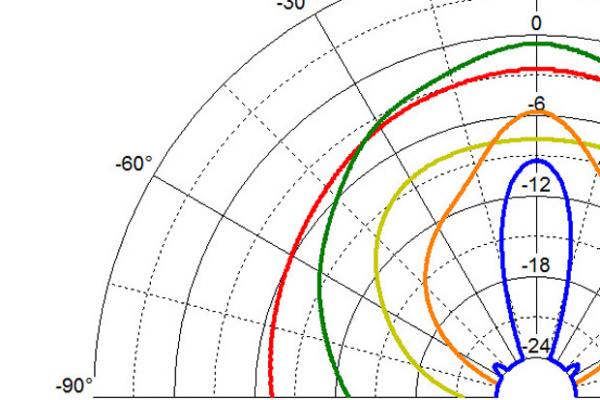Dispersion: A Show and Tell

We tend to think of speakers as devices that blast sound at us. But they actually blast sound in every direction, and that's a good thing. In fact, if they don't blast sound in every direction, it can be a problem.
A speaker's characteristic sound projection pattern, broad or narrow, is referred to as "dispersion."
In home applications, broad dispersion is generally considered good, while narrow dispersion is generally considered bad. Audio geeks refer to a speaker with narrow dispersion as "beamy."
Think about the last hi-fi speaker you heard. It probably sounded pretty good, in part because most of today's speakers have decent dispersion. Now think about the last bullhorn you heard. It surely sounded bad, partly because bullhorns are designed to emit sound in a narrow beam.
Dispersion changes with frequency. In general, the bigger the driver, the narrower its dispersion at higher frequencies. You can easily calculate the frequency at which a driver's dispersion starts to narrow. Just divide 13,512 (the speed of sound in inches per second at sea level) by the diameter of the driver in inches. Thus, a 5-inch driver's dispersion starts to narrow at about 2.8 kHz. The higher the frequency above that, the narrower the dispersion will be. Conversely, at lower frequencies of about 1 kHz and below, dispersion generally isn't an issue.
Why do we care about dispersion?
I can think of five reasons:
- Speakers with broad dispersion tend to create a larger, more enveloping soundfield because there's more high-frequency sound reflecting off the walls of your room.
- Even if sound waves that a speaker emits at, say, 45° to the side (or "off axis") don't hit your ears directly, any waves that aren't absorbed by soft stuff (furniture, carpet, drapes, Bichon Frise, etc.) will eventually find their way to your ears. If the frequency content of these waves varies a lot from the waves that reach your ears directly from the speaker (or "on axis"), it'll sound unnatural.
- Speakers with narrow dispersion in the midrange tend to produce a "cupped hands" coloration, as if the singers or actors you're hearing had their hands cupped over their mouths.
- Speakers with broad dispersion create a more consistent experience for a large group of listeners. Listeners sitting off-axis hear sound that's much more like what the on-axis listeners hear.
- Broad dispersion means speakers are much easier to set up - and much more forgiving of non-optimal placement - because their aim isn't so critical.
Dispersion occurs horizontally, vertically, and every which way in between, but speaker designers are generally most concerned with horizontal dispersion. This is because a seated listener's ears will typically be about at the same level as the speaker's tweeter, so they'll be on roughly the same vertical axis. But it's harder to predict the listener's horizontal position. Maybe she's on a couch in the center of the room, on-axis with the speaker. Or maybe she's in a chair way off to the side. You need consistent horizontal dispersion in order to deliver good sound quality to all those listening positions - and, of course, to multiple listeners.
Interestingly, some monitor speakers designed for recording studio control rooms have relatively narrow dispersion. In that application, broad dispersion generally isn't necessary because the most important listener - the engineer at the mixing board - usually sits very close to the speakers, and much of the control room's wall surface is covered with absorptive material. Thus, most of what the engineer hears is the direct sound from the speakers.





























































